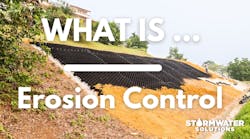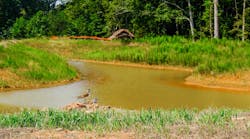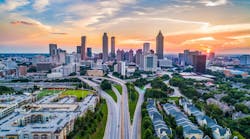What is a bioswale?
A bioswale is a vegetated ditch that allows for the collection of stormwater runoff.
Bioswales are designed and engineered specifically to collect water. They are typically filled with vegetation and permeable materials like mulch. This allows the water to sit for a determined amount of time giving the vegetation and mulch a chance to filter out any debris or pollution within the water runoff.
Gentle slopes, often less than 6%, have been engineered around the bioswale to allow water to flow into them.
The physical makeup of a bioswale is influenced by many different variables including climate, amount of rainfall, site size, budget and vegetation suitability. Bioswales are commonly located along streets and around parking lots.
Purpose of a bioswale
The purpose of bioswales is to pretreat water, by removing contaminants and pollution, before it enters the sewer system.
Having bioswales engineered and implemented around roadways and parking lots also allows for appropriate water runoff. Instead of letting water pool and collect contaminants during a rainstorm, the water can be collected and filtered before it enters the sewer system.
Bioswales also reduce the velocity of stormwater runoff. They are beneficial for protecting surface water and local waterways by keeping them free from excessive pollution and stormwater runoff by filtering contaminants and slowing water velocity.
Difference between rain garden and bioswale
A rain garden is a garden of plants that is watered by stormwater. A rain garden filters stormwater by collecting it at low gradients, slowing it down and allowing the water to settle and be filtered by the native plant life. Pollutants become immobilized or decompose by soil microbes and incorporated into plants.
Rain gardens and bioswales are similar in that they share a common goal of collecting rainwater and filtering it out with plant life and vegetation.
The main difference is that bioswales often allow for more water to run through them. This is due to the engineering aspect of the bioswale. They’re often sunk lower in the ground and feature a more permeable base like gravel and mulch whereas rain gardens are most often only mulch.
Rain gardens are typically located near homes, around a downspout, and by areas where standing water is noticed. Bioswales typically connect with stormwater infrastructure, like sewers, and can be found along property edges, roads and walkways.
What does a bioswale look like?
A bioswale looks like an engineered strip of land, often along roadways or parking lots. They feature a base layer of gravel and mulch that allow for water drainage. Bioswales also have native plant life along them.
The plant life obstructs fast flowing stormwater and slows it down. This allows the stormwater to settle and lets contaminants in the rushing water come to a rest. The native plant life then begins to break down the contaminants in the water before it’s passed into the drainage system.
Bioswales often butt up against sewer systems so the water has a place to flow once its been stagnated by the plant life.
Think of bioswales as engineered ditches, with purposedly planted vegetation on top of permeable rock and mulch.
Challenges of bioswales
Bioswales, just like a backyard garden, require proper maintenance. Accumulation of large sediments from stormwater, trash and improper plant growth can all affect the performance of bioswales.
These can lead to costly restorations. It is important to understand the geography and locations of bioswales. When engineering a bioswale it is important to plan for things like machinery location and the safety of those working. Imagine a maintenance crew coming along with nowhere to park.
Choosing the right plant life is crucial. Native plants are a key to success as they’re acclimated to the surrounding area. Picking the wrong plants can hinder the effectiveness of a bioswale.
Routine inspection and maintenance are crucial for bioswales. Depending on local variables like local government and climate, bioswales should be inspected at least once a year.
Conclusion
Bioswales are an essential part of the water system. They’re engineered and maintained to help provide clean drinking water and ease the burden on water utilities.
A properly implemented bioswale can look beautiful and clean stormwater runoff simultaneously. Utilizing native plant life, it can offer protection for local species all while cleaning stormwater runoff.
They’re one of the first steps toward clean and safe water reuse.








